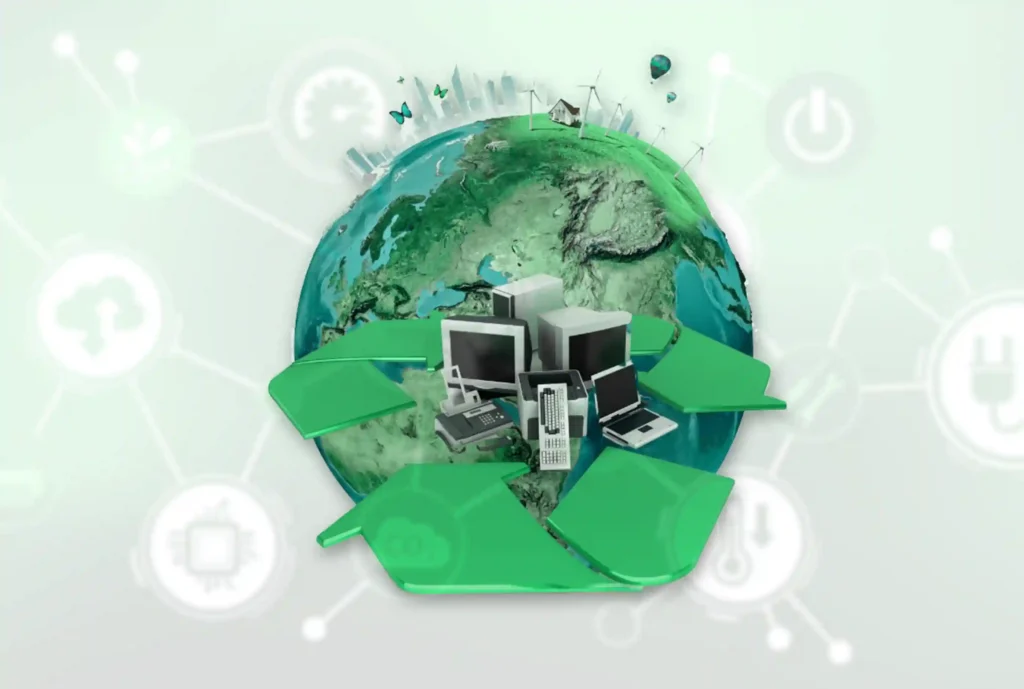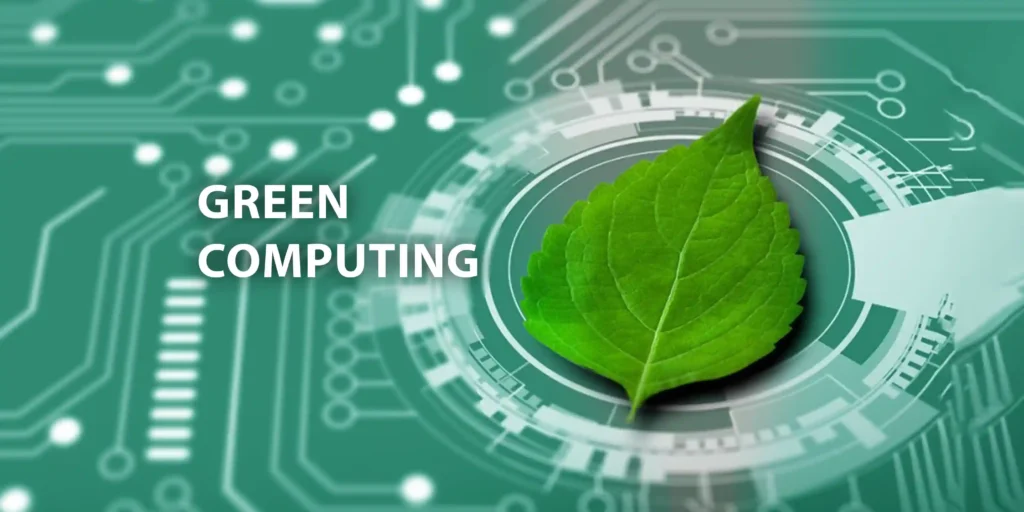Green computing, additionally known as sustainable computing or green era, refers to the exercise of designing, manufacturing, using, and casting off laptop systems and gadgets in an environmentally pleasant way. In ultra-modern international, where environmental worries have become increasingly critical, the idea of green computing has won considerable interest.
Introduction
The primary goal of inexperienced computing is to limit the negative effect that technology can have on our planet. It includes adopting power-green practices and making responsible use of assets in the course of the lifecycle of a laptop machine. This includes reducing power intake, optimizing strength utilization, recycling electronic waste, and promoting sustainable manufacturing techniques.

By introducing green computing ideas, businesses cannot only contribute to a more fit environment but also gain from price and financial savings via reduced power intake. Additionally, green computing practices can enhance brand recognition by showcasing a commitment to sustainability.
In this segment on green computing, we can discover various components, including its definition, key ideas, and practices for enforcing it efficiently. We will delve into the significance of environmentally pleasant computing solutions and discuss real-world examples in which corporations have successfully adopted inexperienced computing strategies.
Join us on this journey to learn more about the importance of green computing and the way it’s shaping a more sustainable future for generations.
The Environmental Impact of Traditional Computing Practices
The environmental impact of conventional computing practices has emerged as a developing concern in recent years. The carbon footprint of computing, which includes the electricity intake and greenhouse fuel emissions related to facts facilities and IT infrastructure, has been on the rise.
Electronic waste control poses every other mission in terms of environmental impact. As generation advances at a fast pace, older devices turn out to be out of date and are discarded. Improper disposal of electronic waste can lead to dangerous chemical substances leaching into soil and water assets.
Data facilities, which are crucial for storing and processing great quantities of digital facts, consume a great quantity of electricity. The use of electricity results in the release of greenhouse gases like carbon dioxide. In truth, it’s far estimated that the worldwide IT region owes approximately 2% of global greenhouse gas emissions.
To mitigate these environmental worries, there may be a need for greater sustainable computing practices. This consists of optimizing fact-center operations to lessen strength intake through technologies like virtualization and green cooling systems. Additionally, proper recycling and disposal techniques must be applied to manage digital waste effectively.
As consciousness grows about the environmental impact of traditional computing practices, there’s an increasing focus on adopting greener options, along with renewable power assets for powering information centers and recycling applications for electronic devices. By enforcing these measures, we can work in the direction of minimizing the negative environmental consequences associated with our reliance on technology.
How Green Computing Can Benefit Businesses and Individuals
Green computing, also referred to as sustainable or eco-friendly computing, is a method that specializes in reducing the environmental effects of technology use. This section explores the blessings of green computing and how it could benefit groups and individuals.
Inexperienced computing plays a crucial role in lowering the general environmental impact of technology use. Sustainable IT practices such as recycling electronic waste, extending the lifespan of devices through proper maintenance and improvements, and using virtualization techniques can appreciably minimize the electronic waste era and conserve treasured sources.
For individuals, embracing inexperienced computing practices no longer only benefits the surroundings but also promotes strength conservation at a personal level. Simple moves like turning off unused devices, making use of power-saving capabilities on computers and different electronics, and recycling vintage devices make contributions to decreased strength consumption and a greener planet.
In addition to fee savings, inexperienced computing enables businesses to enhance their company’s social obligation practices. By actively reducing their carbon footprint through sustainable IT practices, organizations show their dedication to environmental stewardship. This can boost their popularity among clients, traders, and other stakeholders who value companies that prioritize sustainability.
One of the important benefits of green computing is price savings from electricity efficiency measures. By adopting power-green practices consisting of using low-power gadgets, optimizing cooling structures, and imposing energy management techniques, organizations can extensively lessen their energy consumption and lower their software payments. This now not only results in economic savings but additionally contributes to a more sustainable enterprise model.
Green computing offers several benefits for companies and people alike. From price and financial savings through energy efficiency measures to advanced company social responsibility practices and decreased environmental effects via sustainable IT practices, embracing green computing is a win-win state of affairs for absolutely everyone involved.
The Role of Renewable Energy in Green Computing
The role of renewable electricity in green computing is becoming increasingly critical as the demand for computing strength continues to grow. Traditional data facilities consume a significant amount of power, contributing to carbon emissions and environmental degradation. However, the adoption of renewable energy sources, consisting of solar and wind energy, offers a sustainable method to strengthen those computing activities.
The adoption of renewable energy sources for computing sports aligns with the broader purpose of attaining sustainability and mitigating climate change. It no longer only reduces greenhouse gas emissions but also promotes innovation in inexperienced technology. As more companies understand the significance of environmental obligations, we can expect an accelerated emphasis on utilizing renewable electricity in the area of computing.
Similarly, wind power is being explored as a viable choice for powering gadgets and servers used in computing sports. Windmills can generate easy and considerable energy, making them an appealing preference for agencies looking to undertake inexperienced power sources. By integrating wind strength into their infrastructure, corporations can reduce their carbon footprint while preserving reliable strength for their computing needs.
Solar-powered facilities are one instance of how renewable strength may be harnessed to reduce the environmental impact of computing. By utilizing solar panels to generate strength, information centers can substantially lower their reliance on fossil fuels. This no longer only enables reducing carbon emissions but additionally lowers operational fees in the long run.
In conclusion, incorporating sun-powered information centers and harnessing wind energy for powering devices and servers are crucial steps closer to reaching green computing practices. The adoption of those green-strength resources not only reduces environmental impact but also contributes to a greater sustainable future for the generation enterprise.
Best Practices for Implementing Green Computing Strategies
Implementing inexperienced computing strategies is vital in the state-of-the-art global economy, where sustainability and environmental consciousness are gaining growing importance. By adopting great practices, corporations can lessen their carbon footprint and contribute to a greener future.
By implementing those nice practices, businesses can not only most effectively reduce their environmental impact but also gain from value savings through decreased electricity consumption and more efficient resource allocation. Green computing is an ongoing attempt that requires non-stop assessment and development to align with evolving technologies and environmental standards.
Proper recycling and disposal techniques for e-waste are critical components of inexperienced computing strategies. Organizations should partner with licensed e-waste recyclers who follow environmentally accountable practices to make certain that digital equipment is recycled or disposed of adequately. This includes securely erasing information from garage gadgets before disposal to safeguard touchy statistics.
Virtualization and cloud computing also play a considerable role in promoting sustainability. By consolidating multiple digital machines onto a single physical server, agencies can optimize resource utilization and reduce the variety of bodily servers required. In addition, cloud computing enhances this efficiency by permitting businesses to access assets on demand, disposing of the need for maintaining dedicated infrastructure.
One of the important factors in green computing is making strength-efficient hardware alternatives. This entails selecting gadgets that consume much less power in the course of operation, including laptops and servers with Energy Star certification. Additionally, companies can choose stable-state drives (SSDs) rather than traditional difficult disk drives (HDDs), as SSDs consume less energy and produce much less heat.
The Future Outlook: Innovations and Trends in Green Computing
As the world becomes more conscious of the environmental impact of its generation, green computing has emerged as a vital region of consciousness. Tech organizations and authorities are actively enforcing inexperienced IT tasks to reduce electricity consumption and carbon footprints.
The future outlook for inexperienced computing is promising as the era continues to evolve. With ongoing advancements in electricity-efficient technology and growing attention to sustainability, we can count on extra-progressive answers that minimize environmental impact while meeting our developing computational needs.
Additionally, renewable energy resources like sun and wind strength are being integrated into facilities to similarly reduce their environmental effects. Government agencies play a vital role in driving green IT initiatives by imposing rules and supplying incentives for companies to undertake sustainable practices. Many nations have added policies that inspire organizations to apply energy-green technologies and prioritize environmentally pleasant practices.
Data facilities, which consume large amounts of energy, are also undergoing transformation. Innovations, together with virtualization, server consolidation, and superior cooling structures, help optimize power usage in these centers.
One considerable trend in inexperienced computing is the development of energy-efficient technology for computing devices and record facilities. Companies are investing in studies and development to create more strong-green processors, memory modules, and garage devices. These advancements no longer only reduce strength intake but also contribute to the longer battery life of portable gadgets.
FAQ
Green computing can cause financial savings by lowering energy intake and prolonging the lifespan of your IT gadget. It also improves your business’s environmental footprint, which may be a selling point for environmentally conscious customers.
Green computing is applicable to massive corporations and individuals. Everyone can make a difference by using power-efficient gadgets, recycling electronics, and practicing accountable computing habits.
Yes, there are certifications like Energy Star for strength-green devices and LEED (Leadership in Energy and Environmental Design) for sustainable construction practices. These certifications help identify eco-friendly merchandise and practices.
Yes, green computing practices, inclusive of the use of green gadgets and decreasing strength consumption, can result in fee savings for both individuals and organizations over time.
